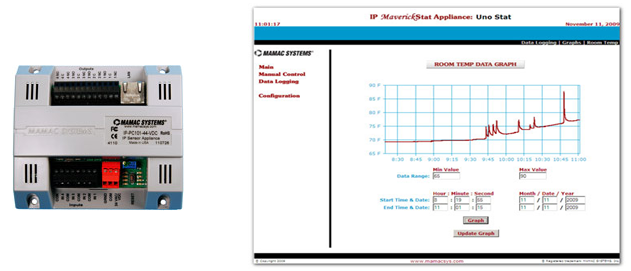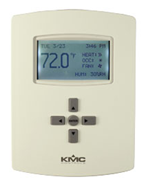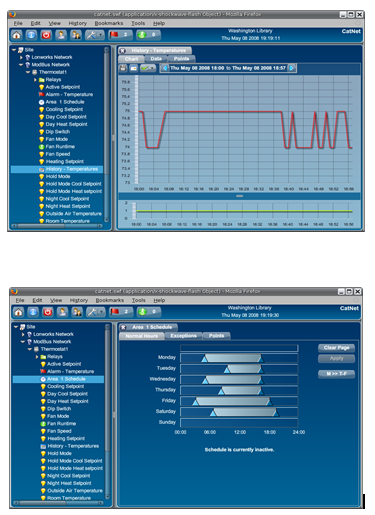|
October 2011
Article
AutomatedBuildings.com
|
[an error occurred while processing this directive]
(Click
Message to Learn More)
|
|
Let's Get Small
That’s
where the future potential of the building automation and control
systems market is – small buildings automation.
|
|
In
the August 2002 issue of automatedbuildings.com, I wrote an article
titled “Does Size Really Matter”. One of the key aspects of the article
was a focus on the overall size and composition of the commercial
buildings market here in the United States. That information, as it
turned out, was not very difficult to come by at all. Starting in 1979,
the U.S. Department of Energy’s Energy Information Administration has
been conducting a survey, the Commercial Buildings Energy Consumption
Survey or CBECS, that provides us with very useful data. The CBECS
collects information on the stock of U.S. commercial buildings, their
energy-related building characteristics and their energy consumption
and expenditures. Commercial buildings include all buildings in which
at least half of the floorspace is used for a purpose that is not
residential, industrial or agricultural, so they include building types
that might not traditionally be considered "commercial," such as
schools, correctional institutions and buildings used for religious
worship. The target population of the survey consists of all commercial
buildings in the United States with more than 1,000 square feet of
floor space. Unfortunately, the results of the last CBECS, conducted in
2007, will not be made public. The following statement from the EIA
addresses the reason for this:
“EIA regrets to report that the 2007 Commercial Buildings Energy
Consumption Survey (CBECS) has not yielded valid statistical estimates
of building counts, energy characteristics, consumption and
expenditures. Because the data do not meet EIA standards for quality,
credible energy information, neither data tables nor a public use file
will be released.“
[an error occurred while processing this directive]A review of the 2003 data will still provide a very relevant picture of
the size and composition of the commercial buildings market for us.
The numbers from that survey are fairly staggering. The survey results
listed the number of commercial buildings present in the year 2003 at
4.86 million. Those buildings comprised a total of 71.6 billion square
feet of floorspace. Approximately 2.6 million buildings were in the
smallest size category (1,001 - 5,000 ft²) with another 948,000
buildings in the next larger category (5,001 - 10,000 ft²). Simple math
tells us that 3.5 million of the 4.86 million total, or roughly 72% of
the total, are less than 10,000 ft² in size. This is precisely the
reason I say “Let’s Get Small”. Make no mistake about it, that’s
where the future potential of the building automation and control
systems market is – small buildings automation.
Armed with that specific knowledge, manufacturers should be focused on
developing, if they haven’t already, products that can deliver today’s
cutting edge technology to this segment of the commercial buildings
market. These products should be priced to make their deployment
economically feasible. It seems reasonable to assume a building owner
isn’t going to invest $15,000 or more into a system for his 3,000 ft²
building - no matter what the “bells & whistles” look and sound
like. These products should also be fairly simple to set up and use and
not require proprietary software and licenses in order to work. The end
game is to give the building owner a simple, affordable and highly
functional product which will allow him to maximize his use of the
product and, subsequently, get the most return on his investment.
Manufacturers who can deliver these types of products should be very
successful in getting their fair share of this market. Fortunately,
there are already manufacturers who have recognized the opportunity
that the small buildings automation market presents, have started down
this path and are providing these solutions. Here are just a few
examples of products that are available right now:
MAMAC Systems: Maverick

The Maverick family of products are IP addressable network appliances
available in a number of different configurations. Typical equipment
control applications {which can be based on setpoint, time schedule or
both} for the Maverick include heat pumps, PTACs, RTUs and split
systems. The Maverick can also be used in monitoring only applications,
like server rooms, “walk in” refrigerator/freezer boxes and
building/tenant electrical consumption and demand. Launch any web
browser, enter the default IP address and connect to the appliance.
There is no proprietary software or license needed in order for the
product to work. The Maverick serves up static web pages with dynamic
data updates every second or two. The above example is an actual data
logging page served up by a Maverick thermostat controller appliance.
The product is specifically targeted to the small buildings market in
price but not in performance. Every model of the Maverick presently
available is less than $500.00. The building owner can harvest useful,
real time data from the Maverick, be in total control of his
environment and receive alarm notifications via e-mail when there is a
problem. Fast food locations, retail stores, bank branches, “portable”
classrooms in school districts, library branches and churches are just
some of the typical small buildings that can benefit from the
installation of this product. There are case studies available on the
manufacturer’s website.
KMC Controls: FlexStat
 The FlexStat is an intelligent, wall mounted thermostat/controller. It
also happens to be a native BACnet Advanced Application Controller
{B-AAC} as well. The FlexStat requires no proprietary software or
license to setup and operate. The FlexStat comes with an on board
library of programs for a variety of applications: heat pumps, fan coil
units, rooftop units and air handling units. Menu screens allow for the
user to easily configure the FlexStat using the buttons on the front of
the FlexStat. There are humidity and motion sensing options available
as well as inputs for adding an outside air temper-ature sensor and fan
status sensor, for example. The FlexStat also provides the building
owner with the future option of networking these products together
{BACnet MS/TP} for integration into a “front end”, or graphical user
interface. Any location where a commercial programmable thermostat
would be considered for installation, like restaurants, small
commercial office buildings and churches, would be a candidate for a
FlexStat. A comparable FlexStat is more expensive than a high end
commercial programmable thermostat but provides more features. Typical
price range is $250.00 to $400.00 for a FlexStat, dependent on the
model.
The FlexStat is an intelligent, wall mounted thermostat/controller. It
also happens to be a native BACnet Advanced Application Controller
{B-AAC} as well. The FlexStat requires no proprietary software or
license to setup and operate. The FlexStat comes with an on board
library of programs for a variety of applications: heat pumps, fan coil
units, rooftop units and air handling units. Menu screens allow for the
user to easily configure the FlexStat using the buttons on the front of
the FlexStat. There are humidity and motion sensing options available
as well as inputs for adding an outside air temper-ature sensor and fan
status sensor, for example. The FlexStat also provides the building
owner with the future option of networking these products together
{BACnet MS/TP} for integration into a “front end”, or graphical user
interface. Any location where a commercial programmable thermostat
would be considered for installation, like restaurants, small
commercial office buildings and churches, would be a candidate for a
FlexStat. A comparable FlexStat is more expensive than a high end
commercial programmable thermostat but provides more features. Typical
price range is $250.00 to $400.00 for a FlexStat, dependent on the
model.
CatNet Systems: CatNet HMI CH-1
 The CH-1 is a self contained, Adobe Flash® based server that provides a
graphical user interface for products that use an assortment of
communicaton protocols. The CH-1 comes equipped with BACnet/IP, BACnet
MS/TP, Modbus I/P, Modbus RTU {RS485} and LON drivers. Animated graphic
screens, scheduling, trending, alarm notification via e-mail and
runtime accumulation are just some of the features available in the
CH-1, as seen in the following screen captures.
The CH-1 is a self contained, Adobe Flash® based server that provides a
graphical user interface for products that use an assortment of
communicaton protocols. The CH-1 comes equipped with BACnet/IP, BACnet
MS/TP, Modbus I/P, Modbus RTU {RS485} and LON drivers. Animated graphic
screens, scheduling, trending, alarm notification via e-mail and
runtime accumulation are just some of the features available in the
CH-1, as seen in the following screen captures.
 No proprietary software or license, nor knowledge of HTML, XML, Flash,
JavaScript or any other programming language, is required to set up and
use the CH-1. With the CH-1 and some inexpensive input/output modules,
a comprehensive system that can control HVAC equipment and lighting,
for example, can be deployed by the building owner. Another example
would be the addition of a CH-1 to a network of KMC FlexStat
con-trollers initially installed to work in stand alone mode. The CH-1
would “web enable” the network of FlexStat controllers and provide the
owner with all of the additional features that the CH-1 offers. Typical price range for the CH-1 is $900.00 to $1,000.00.
No proprietary software or license, nor knowledge of HTML, XML, Flash,
JavaScript or any other programming language, is required to set up and
use the CH-1. With the CH-1 and some inexpensive input/output modules,
a comprehensive system that can control HVAC equipment and lighting,
for example, can be deployed by the building owner. Another example
would be the addition of a CH-1 to a network of KMC FlexStat
con-trollers initially installed to work in stand alone mode. The CH-1
would “web enable” the network of FlexStat controllers and provide the
owner with all of the additional features that the CH-1 offers. Typical price range for the CH-1 is $900.00 to $1,000.00.
Hopefully, we will continue to see new, innovative products
targeted for this market. As long as the products are made readily
accessible, easy to setup and
operate and provide real value for a reasonable price it should prove
to be an interesting future for the small buildings automation market.
About the Author
Frank Miraglia, Vice President, FMS2K Associates, Inc.
Founder and principal consultant Frank Miraglia officially
launched FMS2K Associates, Inc. in March of 2003 in order to provide
the demanding, rapidly evolving controls market with the quality
products and services needed to sustain and propel its seemingly
limitless growth potential. As a multi-faceted company, offering a
combination of state of the art products, consultative services and
training seminars, FMS2K Associates, Inc. is uniquely qualified to
provide your business with the solutions necessary to achieve both
present and future success.
footer
[an error occurred while processing this directive]
[Click Banner To Learn More]
[Home Page] [The
Automator] [About] [Subscribe
] [Contact
Us]